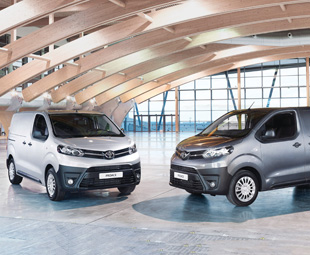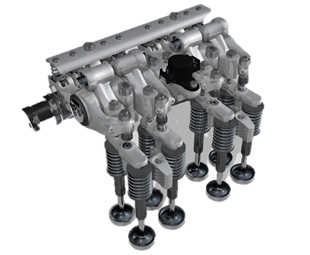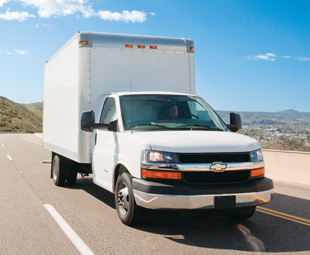New Toyota Proace Van hits UK market

In his monthly review of global news for local truckers, FRANK BEETON updates European van news; looks at the newest engine braking technology from Jacobs Vehicle Systems; discovers yet another cooperative arrangement between General Motors and Navistar; and comments on possible trucking implications of Volkswagen’s latest corporate strategic plan
Back in 2013, when discussing Peugeot/Citroën’s SevelNord integral-van operation, situated at Valenciennes in France, which was building the Jumpy/Expert medium-van range for these brands, we noted that Toyota had announced its intention to purchase between 5 000 and 10 000 spun-off vans annually, and also share in the development costs of the next-generation product.
This was welcome news, as Fiat had withdrawn from participation in an earlier joint arrangement (which saw its Scudo van also built at this venue) and had gone off to join a Renault-led grouping, which was providing its new Talento model. Toyota’s decision to access the Peugeot/Citroën partnership for its ProAce van would, therefore, make a significant contribution to the future viability of the SevelNord operation.
The new generation emerges
During its world debut at this year’s Geneva Motor Show, held in March, the new-generation SevelNord product emerged as the Peugeot Traveller, Citroën Spacetourer and second-edition Toyota ProAce.
Since then, the new ProAce van has been launched on to the United Kingdom (UK) market, with two wheelbase options, three body sizes and payload capacity up to 1,4 t. It features Euro-6-compliant 1,6 and 2,0-litre turbocharged diesel engines covering the power spectrum from 70 to 90 kW (95 to 120 hp), driving through five- or six-speed manual transmissions. The range consists of panel vans, crew-cab combi versions, people movers and a platform/cab unit that can accommodate special bodywork applications.
The ProAce is available with several trim and equipment levels, the most comprehensive of which includes: stability control, hill-start assist, pre-collision system, adaptive cruise control, head-up display, cornering lights, rain-sensing windscreen wipers, dusk-sensing headlights, auto-dimming rear-view mirror, multimedia system, satellite navigation, 17-inch alloy wheels, air-conditioner, cooled and illuminated glovebox and front fog lamps.
Unlikely local connection
Is there any chance of the ProAce coming to South Africa? We don’t think so, as it is positioned too close, in payload terms, to the locally produced Quantum van/minibus line-up. In South Africa, many integral vans are converted into long-distance mini- and midi-bus taxis. In that area of activity we cannot see this class of vehicle being considered an alternative to the larger Sprinter/Crafter-size vehicles, with their dual rear wheels.
However, we still believe that there is potential for Toyota to look at the larger SevelSud product range – made up of the Fiat Ducato, Peugeot Boxer and Citroën Jumper/Relay – as a source for a future European market product.
The SevelSud arrangement is due to persist until at least 2019, and there is sure to be a major facelift or model change before then, which will provide an ideal opportunity for Toyota to explore options, including a possible South African market entry.
LATEST JAKE BRAKE LAUNCHED IN EUROPE
Safely controlling the speed of a heavily loaded truck on a long downhill stretch has been a challenge ever since motorised road transport presented itself as a serious alternative to railways early in the 20th century.
Very early foundation braking systems, which often worked only on the propeller shaft, or one of the vehicle’s axles, were singularly ineffective if used continuously to control speed. The situation did not really improve to any extent even when drum brakes were applied at all wheel positions.
 Frequent braking led to overheating of the friction material and/or hydraulic brake fluid, and serious accidents through loss of control were often the unfortunate result. The advice given to drivers – that they should engage the same gear when descending a particular hill as they would have needed to climb it, in order to maximise the braking effect of the engine “running against compression” – was not always followed, often with disastrous consequences.
Frequent braking led to overheating of the friction material and/or hydraulic brake fluid, and serious accidents through loss of control were often the unfortunate result. The advice given to drivers – that they should engage the same gear when descending a particular hill as they would have needed to climb it, in order to maximise the braking effect of the engine “running against compression” – was not always followed, often with disastrous consequences.
Over the years, various technologies have been developed to improve the situation, and allow loaded trucks to travel safely downhill at higher speeds than the crawl that inevitably resulted from the gearing-down technique described above.
The simple exhaust brake, employing a butterfly valve to close off the exhaust manifold, and increase the engine’s braking effect, was an important advance that was widely used on European trucks from the 1950s. However, an American solution, which also involved additional control of the exhaust-valve opening, was even more effective.
After being industrialised by the Jacobs Manufacturing Company in 1951, this compression-release brake became widely known as the “Jake Brake”, and was characterised by a loud staccato, almost machine gun-like sound, when deployed.
The principle employed was that the cylinder’s exhaust valve would be opened towards the end of the piston’s compression stroke, thus releasing the energy that would normally have been fed back to the crankshaft during the subsequent power stroke, and increasing the braking effect of the engine.
Enter the High Power Density Engine Brake
During 2011, Jacobs Vehicle Systems (JVS) revealed its High Power Density Engine Brake in the United States (US). This differs from the traditional Jake Brake in also opening the inlet valve at the appropriate time, providing two braking events during each camshaft rotation.
JVS has claimed substantial benefits for this system, including one-and-a-half times the braking performance over the engine’s entire operating range, more than twice the retardation performance at low revs, lower noise, and beneficiation of the exhaust after-treatment system’s thermal management.
Additional claimed benefits – including improved engine start-up and shut-down, with reduced cab vibration and shaking – reduce the driver’s temptation to leave the engine idling for extended periods and lead to further reductions in fuel consumption and emissions.
The HPD system is said to be suitable for use in the modern generation of smaller displacement diesel and gas-fuelled engines, whereas traditional compression-release systems were usually applied to larger displacement units. It is also claimed that use of this system could potentially remove the need for the hydraulic driveline retarders currently favoured by European truck manufacturers, adding some 175 kg to the vehicle’s legal payload capacity.
JVS currently supplies its products to the North American heavy-duty diesel manufacturers as well as Hino, Hyundai, Mitsubishi, DAF, Daimler, Renault, Deutz and Volvo. The European launch of the HPD system, which took place at the Millbrook Proving Ground in the UK during April, was clearly intended to raise awareness of the latest system and its benefits in a market where smaller-capacity diesel and alternative-fuel engines are widely used.
ANOTHER GENERAL MOTORS/NAVISTAR LINK-UP
Back in 2015, we looked at the growing success of European-style integral panel vans in the North American market. An increasing number of models, spun off from European product platforms, but with some level of adaptation for American tastes, were taking leading positions in the small and large commercial-van segments of the US market. It was notable that the market leaders in both of these categories had European parentage.
 In the heavier van class, Ford’s Transit had taken the lead. Among the “also-rans” were the Chevrolet Express and GMC Savana models from General Motors (GM), which are both badge-engineered derivatives of the company’s indigenous North American “G Van” family.
In the heavier van class, Ford’s Transit had taken the lead. Among the “also-rans” were the Chevrolet Express and GMC Savana models from General Motors (GM), which are both badge-engineered derivatives of the company’s indigenous North American “G Van” family.
This consists of integral van, people mover and “cutaway” chassis/cab models; the latter intended for the fitment of bespoke bodywork in the aftermarket, for use in service vehicle, ambulance or bus applications.
G Van details
The technical specification catalogue of the G Van family includes a choice of 4,8-litre or 6,0-litre V8 petrol engines, a 6,6-litre V8 turbodiesel, six-speed transmission and rear-wheel drive, with single or dual rear wheel fitment. GVM ratings stretch up to around 6,5 t. There are two wheelbase options for the integral models, and three for the cutaways.
The “cutaway” designator indicates that the semi-forward control cab is not closed off at the rear, leaving the buyer with a choice to have access between the driver’s compartment and the interior of the rear body, if required.
Despite the apparent swing to European-style vans, GM seems intent on continuing with the G Van line-up for its home market. Early in June, it was announced that Navistar Inc. would be building the cutaway derivatives, on GM’s behalf, at its Springfield, Ohio plant, from the first half of 2017.
GM has said that this arrangement will free up its Wentzville, Missouri plant to keep up with demand for its mid-size trucks, and the integral-van derivatives of the G Van family. However, we cannot help thinking that the longer-term future may include consideration of European products, based on the Vauxhall and Opel models produced in GM’s van partnerships with Renault and Nissan.
In September 2015, a long-term agreement was announced between Navistar and GM covering the development and assembly of conventional-cab Class 4/5 commercial vehicles (roughly 6,4 to 8,9 t gross vehicle mass ratings) which will be sold with both International and Chevrolet branding, from 2018 onwards.
The joint-venture vehicles will also be built by Navistar at its Springfield, Ohio, facility, which is to gain an investment of $US 12 million (about R174 million) and 300 additional jobs as a result of the medium truck arrangement, with the G Van programme adding a further 300 work opportunities.
Does Volkswagen still have its eye on Navistar?
It was back in 2012 that we first reported on rumblings that Volkswagen (VW) AG may have been interested in acquiring Navistar International, in order to gain immediate and substantial access to the North American heavy-duty truck market.
At the time, VW was rolling out its strategy for global motor industry leadership, and with the recognition that its Scania and MAN assets had no substantial presence in that market, nor the dedicated conventional (bonneted) models that would be necessary to make a significant entry, the acquisition of Navistar, its products and distribution structure, would have provided a quick and easy way forward.
No visible progress towards such a takeover has been made up to now, and Volkswagen has had to confront its own very substantial demons in the shape of the diesel-emissions scandal since then, so speculation over an intended takeover has abated.
Earlier this year, in our article discussing the possible implications of the scandal, we questioned whether VW would still have the appetite, or means, to continue building or expanding its Volkswagen Truck and Bus GmbH empire, or if it would consider scaling down, or even selling off some of the elements in order to finance corrective actions.
We also pointed out that the Truck and Bus operation still faced challenges, including Scania and MAN’s adversarial history, and considerable market coverage overlap by the two brands in both geographic and product-related terms.
New strategic announcement
During June, VW’s CEO Matthias Müller announced details of the group’s latest long-term corporate strategy, which, inter alia, included the goal of making VW Truck & Bus “the most profitable company in the sector, with a significant presence in all key regions of the globe”.
Commentators immediately seized on this as a firm indication that a North American market entry was, once again, on the planning horizon, and that the acquisition of Navistar International had returned to the agenda. However, Navistar has built some new partnerships since 2012, which may complicate a potential acquisition plan.
We do not think that the magnitude of Navistar’s recently concluded cooperation agreements with GM will be sufficient, in their own right, to scupper any potential takeover bid, but it may be possible that GM, with its sights apparently set on resurrecting some of its own domestic truck business, could move to secure its supply position.
Further, the US government, recognising Navistar’s importance as a supplier of vehicles to its military, will not be in favour of the company coming under foreign ownership.
As it stands, only Navistar and Paccar still remain as major US-owned truck manufacturers.
There is also an indication, in the VW strategic announcement, that “in the medium term, the truck and bus business unit will increasingly evolve from a pure-play commercial vehicle manufacturer to a leading provider of intelligent transport solutions”. This may suggest that added-value services – such as autonomous driving, and transport on demand; a sort of “Uber for trucking” – will provide the main short-term focus, while geographic market expansion and acquisitions may follow later.
Our take is that VW has emphatically reaffirmed its commitment to the commercial vehicle business, and given the size and financial strength of the group, even in the aftermath of the emissions scandal, anything will be possible.
Global FOCUS is a monthly update of international news relating to the commercial vehicle industry. It is compiled exclusively for FOCUS by Frank Beeton of Econometrix.
Published by
Focus on Transport
focusmagsa




